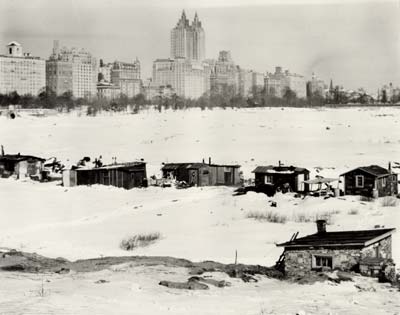I chose Central Park for my “Then and Now” blog post because it is one of the few places in New York that has largely remained constant throughout the years. While people, places, and things have come and gone throughout the city, many areas within Central Park look just as they did over a century-and-a-half ago. Central Park allows visitors to travel to any time period between the present and its creation. The rock you lay upon today has been laid upon by countless people before you, and they very likely gazed upon the same field or grove of trees.
In 1857 Frederick Law Olmsted’s proposal was the winner of a design contest for the layout of the park. By the mid 1860s, millions were visiting the park each year. Attractions, including concerts, the carousel, tennis, bicycling, and the ever popular Central Park Zoo brought more and more visitors to the park throughout the rest of the nineteenth century.
The twentieth century was a dynamic one for Central Park. Central Park’s famous Great Lawn was once a large rectangular reservoir. Not long after the stock market crashed, the reservoir was drained as the City no longer wished to maintain it. Plans for its re-purposing slowed and thus a large empty basin was left. “Hoovervilles” sprang up in place of the reservoir. Said one man regarding his shack, “We work hard to keep it clean, because that is important. I never lived like this before.” In 1932, the Parks Department referred to the emptied reservoir as Hoover Valley. The New York Times states that “As the Depression set in, public sentiment became more sympathetic. In July 1931 a judge suspended the sentences of 22 unemployed men sleeping in Central Park — apparently in various locations — and gave each one $2 out of his own pocket.”
In 1934, Robert Moses took charge of the City’s parks, acquired federal funds, and “built 20 playgrounds on the park’s periphery, renovated the Zoo, realigned the drives to accommodate automobiles, added athletic fields to the North Meadow, and expanded recreational programming.” These were lasting amendments to the park that still exist today.
The Central Park Conservancy was formed by a group of concerned New Yorkers after the park, like much of the city, went through a period of great decline in the 1970s. They now handle the majority of the parks operations, and are mostly privately funded. Today the park is constantly being maintained and refurbished and remains a free alternative for New Yorkers, even during times of financial distress.
Sources:
1) http://www.centralparknyc.org/
2) http://www.nytimes.com/1993/08/29/realestate/streetscapes-central-park-s-hooverville-life-along-depression-street.html?pagewanted=2&src=pm
3) http://www.centralpark.com/guide/history.html




 My name is
My name is 